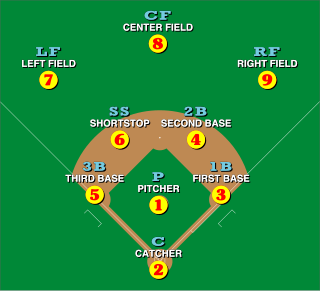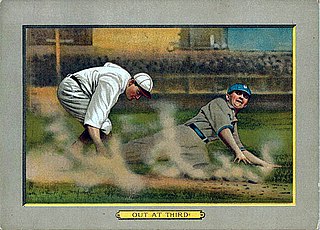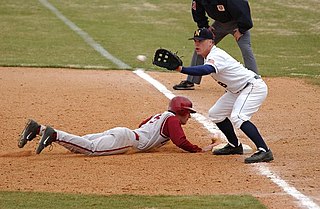
Infield is a sports term whose definition depends on the sport in whose context it is used.

Infield is a sports term whose definition depends on the sport in whose context it is used.
In baseball, the diamond, as well as the area immediately beyond it, has both grass and dirt, in contrast to the more distant, usually grass-covered, outfield. The "diamond" can also refer to the defensive unit of players that are positioned in the region: first baseman, second baseman, shortstop, third baseman. Sometimes it includes the catcher and pitcher who (as a tandem) are often referred to separately as the battery.[ citation needed ]
In baseball the physical infield is where most of the action in a baseball game occurs, as it includes that area where the all-important duel between the pitcher and batter takes place. [1] The pitcher stands on the pitcher's mound (a raised mound of dirt located at the center of the infield) and from there he pitches the ball to his catcher, who is crouched behind home plate sixty feet, six inches away at what might be called the cutlet of the diamond-shaped baseball field. To the left and right of the catcher are chalk boxes in the dirt called batter's boxes. The opposing team's batter must stand in one of the two boxes and from there he will attempt to hit the pitched ball with his bat. The umpire, who officiates the game, stands behind the catcher. The other important parts of the infield are the three bases, first base (to the pitcher's left, looking toward home plate), second base (behind the pitcher) and third base (to the pitcher's right). Together, home plate and the three bases form a diamond around the pitcher, with each side of the diamond measuring 90 feet (27 m). [1]
In cricket infield is a central oval on the cricket field, the reference point for fielding restrictions in short forms of the game; in contrast to the more distant outfield.[ citation needed ]
Infield can refer to a region inside a closed race track used for horse racing or auto racing, or to an area encircled by the track of a roller coaster.[ citation needed ]

In the sport of baseball, each of the nine players on a team is assigned a particular fielding position when it is their turn to play defense. Each position conventionally has an associated number, for use in scorekeeping by the official scorer: 1 (pitcher), 2 (catcher), 3, 4, 5, 6 (shortstop), 7 8, and 9. Collectively, these positions are usually grouped into three groups: the outfield, the infield, and the battery. Traditionally, players within each group will often be more able to exchange positions easily ; however, the pitcher and catcher are highly specialized positions and rarely will play at other positions.

Softball is a game similar to baseball played with a larger ball on a field that has base lengths of 60 feet, a pitcher's mound that ranges from 35 to 43 feet away from home plate, and a home run fence that is 220–300 feet away from home plate, depending on the type of softball being played. Softball is played competitively at club levels, the college level, and the professional level.

In baseball, the pitcher is the player who pitches the baseball from the pitcher's mound toward the catcher to begin each play, with the goal of retiring a batter, who attempts to either make contact with the pitched ball or draw a walk. In the numbering system used to record defensive plays, the pitcher is assigned the number 1. The pitcher is often considered the most important player on the defensive side of the game, and as such is situated at the right end of the defensive spectrum. There are many different types of pitchers, such as the starting pitcher, relief pitcher, middle reliever, lefty specialist, setup man, and the closer.

Catcher is a position for a baseball or softball player. When a batter takes their turn to hit, the catcher crouches behind home plate, in front of the (home) umpire, and receives the ball from the pitcher. In addition to this primary duty, the catcher is also called upon to master many other skills in order to field the position well. The role of the catcher is similar to that of the wicket-keeper in cricket, but in cricket, wicketkeepers are increasingly known for their batting abilities.

A first baseman, abbreviated 1B, is the player on a baseball or softball team who fields the area nearest first base, the first of four bases a baserunner must touch in succession to score a run. The first baseman is responsible for the majority of plays made at that base. In the numbering system used to record defensive plays, the first baseman is assigned the number 3.

In baseball, an out occurs when the umpire rules a batter or baserunner out. When a batter or runner is out, they lose their ability to score a run and must return to the dugout until their next turn at bat. When three outs are recorded in a half-inning, the batting team's turn expires.

The rules of baseball differ slightly from league to league, but in general share the same basic game play.

A baseball field, also called a ball field or baseball diamond, is the field upon which the game of baseball is played. The term can also be used as a metonym for a baseball park. The term sandlot is sometimes used, although this usually refers to less organized venues for activities like sandlot ball.

In baseball, part of the infielders' and pitcher's jobs is to cover bases. That is, they stand next to a base in anticipation of receiving the ball thrown from another fielder, so that they may make a play on an opposing baserunner who is approaching that base. On a force play, the fielder covering the base stands with one foot on that base.

Baseball and cricket are the best-known members of a family of related bat-and-ball games. Both have fields that are 400 feet (120 m) or more in diameter between their furthest endpoints, offensive players who can hit a thrown/"bowled" ball out of the field and run between safe areas to score runs (points) at the risk of being gotten out, and have a major game format lasting about 3 hours.
This is an alphabetical list of selected unofficial and specialized terms, phrases, and other jargon used in baseball, along with their definitions, including illustrative examples for many entries.